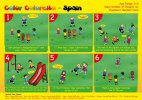Hello there,
I really need some serious help in the development of my final major project (MA Graphic Design). I have mentioned below the brief description of the project. Some suggestion/help will be highly appreciated.
Disappearing Traditional Childhood Games
Children in the schools just play football or few other playground games, because they don't know much games. So if they get introduced to new games they will definitely like them and enjoy playing them. This will promote awareness of different cultures from all around the world through games as well as they will be involved in physical activities, which in normal case is not much seen.
The aim of the project is to promote traditional childhood games from all over the world to the children in the schools in the UK.
I have to develop a solution or a way to visually present these games to children (away from technology), so they can enjoy playing these games. I have already collected a list of games from all over the world, which I am intending to produce as final outcome.
Solutions I had thought of doing..
• Comics Book representing these games.
• Playground Markings of these games.
• Compendium Box ( this will be a box which will have all the materials needed to play the games for ex- comics book to explain the rules of the games, colorful stones, ropes etc)
Thanks a lot
I really need some serious help in the development of my final major project (MA Graphic Design). I have mentioned below the brief description of the project. Some suggestion/help will be highly appreciated.
Disappearing Traditional Childhood Games
Children in the schools just play football or few other playground games, because they don't know much games. So if they get introduced to new games they will definitely like them and enjoy playing them. This will promote awareness of different cultures from all around the world through games as well as they will be involved in physical activities, which in normal case is not much seen.
The aim of the project is to promote traditional childhood games from all over the world to the children in the schools in the UK.
I have to develop a solution or a way to visually present these games to children (away from technology), so they can enjoy playing these games. I have already collected a list of games from all over the world, which I am intending to produce as final outcome.
Solutions I had thought of doing..
• Comics Book representing these games.
• Playground Markings of these games.
• Compendium Box ( this will be a box which will have all the materials needed to play the games for ex- comics book to explain the rules of the games, colorful stones, ropes etc)
Thanks a lot
